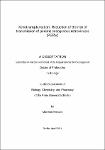Xenotransplantation: Reduction of the risk of transmission of porcine endogenous retroviruses (PERV)
Semaan, Marwan
Xenotransplantation using porcine cells, tissues or organs may reduce the widening gap between demand and supply of human donor organs. However, this may be hampered by the presence of porcine endogenous retroviruses (PERVs), which belong to the γ-retroviruses family and are integrated in the porcine genome and were shown to infect human cells in vitro. Three subtypes of PERVs were identified, PERV-A and PERV-B are human tropic and pose a direct risk and are ubiquitous while PERV-C infect only pig cells and is not present in all pig strains. To date, there are no records of in vivo transmission of PERVs to human or primates following porcine material xenotransplantation. Nevertheless, many of the γ-retroviruses are pathogenic and able to induce tumors and immunodeficiency, which can’t be excluded for PERVs. While breeding animals under SPF conditions may eliminate most of pathogens and exogenous viruses, PERVs are difficult to eradicate from the porcine genome and different strategies must be used to prevent their possible transspecies transmission to human. The present study is a contribution to the evaluation of the risks imposed by xenotransplantation as well as to the prevention of PERV transmission to human. Although PERV-C is not human-tropic, the high infectious PERV-A/C which results from the recombination between PERV-A and PERV-C raised a major concern for xenotransplantation. For this reason choosing PERV-C-free strains with low PERV expression is relevant. The first part of this work addresses the prevalence and the expression of PERV in Göttingen minipigs, which are used for numerous biomedical investigations and are well characterized. PERV-A, -B and -C were found in all animals tested and their expression was low. Infection of human 293 cells was not observed even after mitogen treatment of the pig peripheral blood mononuclear cells (PBMCs). RNA interference was used in order to reduce the expression of PERVs in pigs and transgenic pigs expressing PERV-pol-specific shRNA were generated in our group. In the second part of this study the long term effects of PERV specific RNA interference and reduction of PERV expression in these pigs was investigated. Over 3 years, the expression of shRNA was persistent and PERV expression was consistently reduced in the pig PBMCs. We also investigated the expression of PERV and shRNA in different organs of the pigs. Moreover, new triple-shRNA expressing vectors were produced using high efficient siRNAs. The use of these vectors showed a significant improvement in reducing the PERV expression in vitro. The third part focuses on the use of zinc finger nucleases (ZFN) to knockout PERV genes. ZFN specific for the PERV-pol gene were used, and expression of ZFN proteins in porcine kidney cells was demonstrated by different methods. However, the high rate of ZFN expression and the high copy number of PERV proviruses seemed to have cytotoxic effects. ZFN activity couldn’t be detected since a surveyor nuclease assay widely used for detection of ZFN induced gene disruption couldn’t be applied in this case. In the last part vaccine strategies to prevent PERV transmission were investigated. Neutralizing antibodies directed against the recombinant viral envelope proteins gp70 and p15E were produced in hamsters. The neutralization effect of the immunized sera was measured using a qRT-PCR based neutralization assay. To summarize, this work contributed into improving the reduction of PERV expression by RNAi, and addressed for the first time the possibility of the use of ZFNs to knock out a gene with high copy number such as PERV.
Dateien zu dieser Publikation
Keine Lizenzangabe

